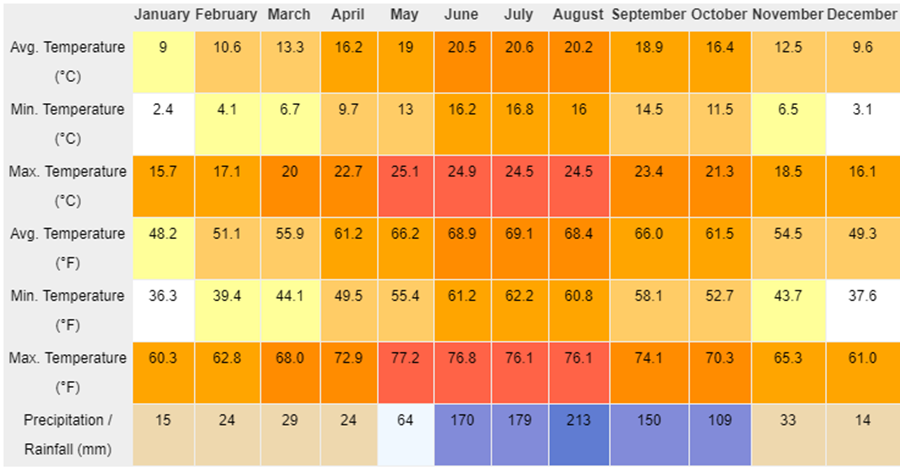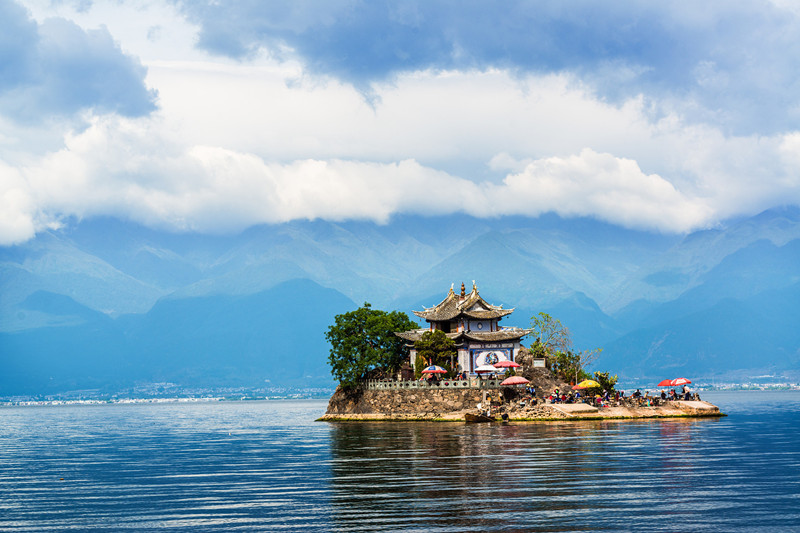
Dali Climate
Dali Climate is low latitude plateau monsoon climate, which is characterized by small temperature difference between four seasons. Dali, known as the "Oriental Switzerland", has around 126 days in the year at the temperature of 18-21℃, which is the most appropriate temperature for a holiday. In addition, it enjoys abundant sunshine, which is most popular during the winter due to its high altitude. Dali Weather & Climate describes information with Dali Climate Graph, Dali Climate Data, What to Wear in every season, Weather and Climate by month, Dali Climate Yearly. Find out the best time to visit Dali and see the highlights of every season in Dali.
Dali Climate & Weather
Dali Weather Graph by Month

The dry month occurs in December with the average rainfall of 14 mm. The month with the maximum rainfall is August with the average precipitation of 217 mm.
Dali Average Temperature

The highest temperature occurs in July at around 20.6°C and the lowest temperature occurs in January at about 8.9°C. Dali is a place without hot summer and cold winter.
Dali Weather by Month

There is a difference of 199 mm of precipitation between the driest and wettest months. The average temperatures vary during the year by 11.6 °C.
Read more:
Four Seasons of Dali and What to Pack
- Spring (March - May): It is said that the spring of Dali is the most beautiful. It is neither hot nor cold at this time of the year. The grasses are tall and the nightingales are in the air. When it comes to Dali, whether in the tourism publicity photo or in Jin Yong’s martial arts novels, you shall not miss the Three Pagodas and Chongsheng Monastery, Cangshan Mountain, Erhai Lake. When traveling to Dali in spring, remember to bring a thick coat, because it was still very cold at night.
- Summer (June - August): In summer, Dali is the best place for people to take a summer vacation. The temperature is only around 20℃. If it rains, it is only around 10℃, which is very cool. Summer is the peak of Dali tourism. At this time, Dali is alive and well, the plants have grown lush foliage, and the bare mountains are covered with green. When traveling to Dali in summer, remember to bring an umbrella, because summer is the rainy season in Dali, and you should pay attention to sun protection when going out. The ultraviolet rays here are very strong.
- Autumn (September - November): Dali in autumn is less enthusiastic and energetic than that in summer, and the climate is milder. The rainy season has passed, you are no longer afraid of sudden heavy rain. However, the temperature difference in the autumn is large, it is a bit cold in the morning and evening. When traveling to Dali in fall, remember to bring a jacket and sweater.
- Winter (December - February): Dali in winter has the unique beauty. The white snow on Cangshan Mountain, the bare ancient wood in the Dali Ancient Town, and the strong winds of Xiaguan are all characteristics of winter. Dali in winter is not cold. Even if it is only a few degrees, it is more comfortable than the northern parts of China. It is very warm to wear a sweater coat. When traveling to Dali in winter, remember to bring moisturizer, otherwise the skin will be chapped.
Best Time to Visit Dali
This subtropical highland monsoon climate makes Dali a popular destination which can be visited all year round with warm temperature, lots of sunshine and fresh air. It is most popular during winter months for those people who live in a cold region. March-June is the best time to visit Dali, especially in spring.
Travel Tips for Visiting Dali
- In China, avoid to travel in peak seasons, such as Chinese New Year, International Labor Day and National Day. While if you want to experience the traditional festival culture, taking a tour during the traditional festivals of China can get the opportunity to experience the festivals culture.
- Be careful of the changeable temperature. A few chilly days could be followed by relatively hot weather. So it is better to take some early winter clothes to protect you away from the sudden low temperature.

 7 Days GolfingTour
7 Days GolfingTour
 8 Days Group Tour
8 Days Group Tour
 8 Days Yunnan Tour
8 Days Yunnan Tour
 7 Days Shangri La Hiking
7 Days Shangri La Hiking
 11 Days Yunnan Tour
11 Days Yunnan Tour
 6 Days Yuanyang Terraces
6 Days Yuanyang Terraces
 11 Days Yunnan Tour
11 Days Yunnan Tour
 8 Days South Yunnan
8 Days South Yunnan
 7 Days Tea Tour
7 Days Tea Tour
 8 Days Muslim Tour
8 Days Muslim Tour
 12 Days Self-Driving
12 Days Self-Driving
 4 Days Haba Climbing
4 Days Haba Climbing
 Tiger Leaping Gorge
Tiger Leaping Gorge
 Stone Forest
Stone Forest
 Yunnan-Tibet
Yunnan-Tibet
 Hani Rice Terraces
Hani Rice Terraces
 Kunming
Kunming
 Lijiang
Lijiang
 Shangri-la
Shangri-la
 Dali
Dali
 XishuangBanna
XishuangBanna
 Honghe
Honghe
 Kunming
Kunming
 Lijiang
Lijiang
 Shangri-la
Shangri-la
 Yuanyang Rice Terraces
Yuanyang Rice Terraces
 Nujiang
Nujiang
 XishuangBanna
XishuangBanna
 Spring City Golf
Spring City Golf
 Snow Mountain Golf
Snow Mountain Golf
 Stone Mountain Golf
Stone Mountain Golf













